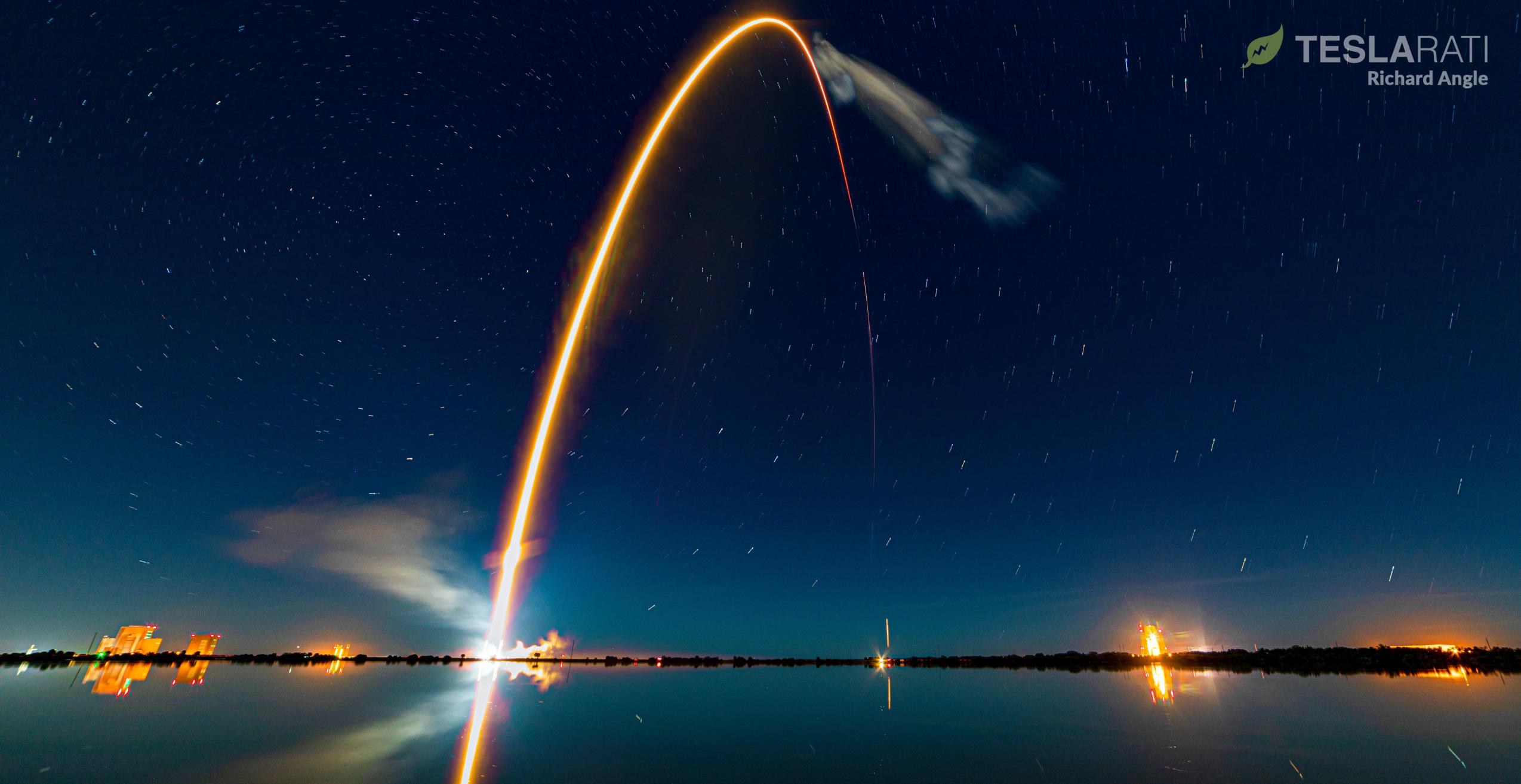
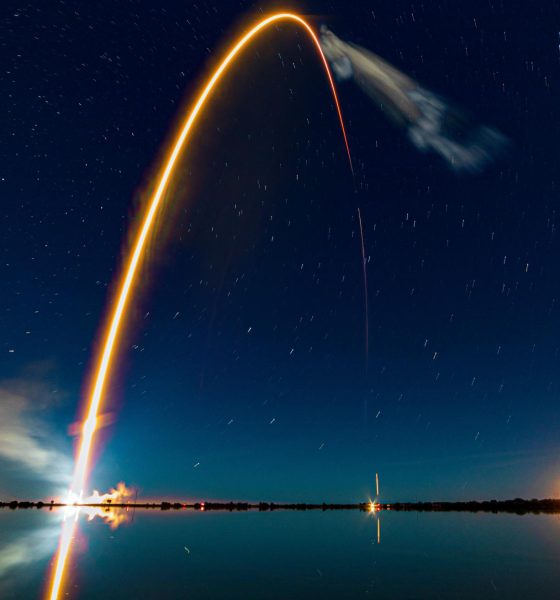
News
[Update] SpaceX rocket launch kicks off a potentially record-smashing year for Falcon 9
Update: After spinning itself around its vertical axis a bit like a propeller, SpaceX’s expendable Falcon 9 upper stage has successfully released a massive stack of 60 Starlink v1.0 satellites for the second time in two months. Designing to tolerate the occasional bump during their bizarre deployment, those 60 satellites will quickly spread out in space and deploy their solar arrays an hour or so after separating from Falcon 9’s upper stage.
Perhaps as early as later this evening or sometime on January 7th, all 60 satellites will fire up their krypton ion thrusters, beginning the process of temporarily raising their orbits to 350 km (220 mi). Once there, SpaceX will more extensively verify the health of each spacecraft and – if all looks well – send all 60 on their way to a final circular 550 km (340 km) orbit where they will join their brethren and begin operating as communications satellites.
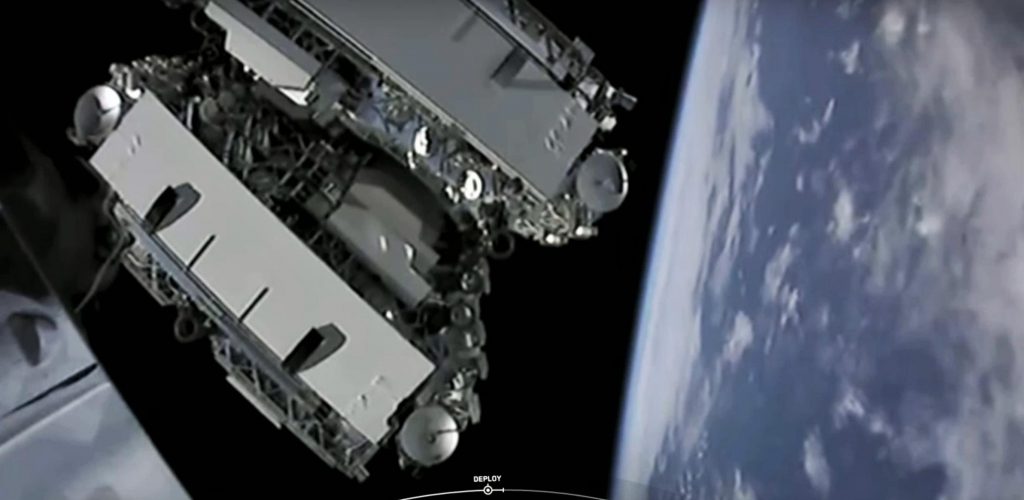
A SpaceX Falcon 9 has kicked off what could be a record-smashing year, potentially making SpaceX the world’s most prolific launch company thanks in large part to the game-changing reusability of its Falcon rockets.
At 9:19 pm ET on January 6th (02:19 UTC, Jan 7), Falcon 9 booster B1049’s nine Merlin 1D engines came to lift, lifting the two-stage rocket and its payload of 60 Starlink satellites off the pad and sending them on their way to orbit. Minutes later, the Falcon 9 booster shut off – completing its fourth successful launch in 17 months – and flipped around with small cold-gas thrusters, beginning its trip back down to Earth.
Less than nine minutes after lifting off from SpaceX’s LC-40 pad at Cape Canaveral Air Force Station (CCAFS), Falcon 9 B1049 began its landing burn and gently touched down on drone ship Of Course I Still Love You (OCISLY), stationed more than 600 km (375 mi) downrange in the Atlantic Ocean. Seconds later, the mission’s expendable Falcon 9 upper stage shut off its Merlin Vacuum (MVac) engine, completing the first of two burns and placing the rocket and its Starlink payload in a parking orbit.
Known as Starlink V1 L2, referring to the second launch of Starlink v1.0 satellites, this mission crossed off several SpaceX milestones – both internal and external. For Falcon 9, it marked the company’s 48th successful landing of an orbital-class rocket booster, as well as the second time SpaceX has successfully launched and landed the same booster (this time B1049) four times in a row.
Even more significantly, it’s almost certain that – so long as all 60 Starlink V1 L2 satellites successfully deploy and begin orbit-raising – SpaceX will have become the owner and operator of the world’s largest commercial satellite constellation. After tonight’s launch, SpaceX’s Starlink internet constellation will likely measure some 175 operational satellites strong less than eight months after the company began dedicated internal launches.
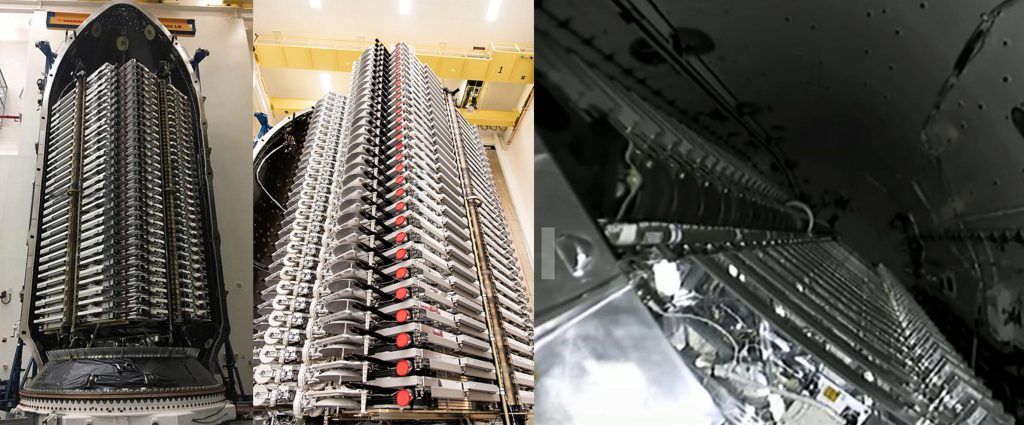
Assuming drone ship OCISLY safely returns Falcon 9 B1049 to port and including SpaceX’s successful November 2019 Starlink V1 L1 launch, the company now possesses two Falcon 9 boosters – B1048 and B1049 – that have successfully performed four separate orbital-class launches apiece. With two rockets in hand, SpaceX should be able to far more accurately determine just how well they’re standing up to the rigors of the latest reusability milestone, hopefully giving the company the data it needs to rapidly turn around one or both boosters for a fifth launch in the near future.
SpaceX has 20-24 Starlink launches planned for 2020, so the company will have a wealth of opportunities to push its fleet of reusable rockets to their limits, ranging from attempting nth booster reuses to testing and expanding the envelope of SpaceX’s nascent payload fairing reuse program.
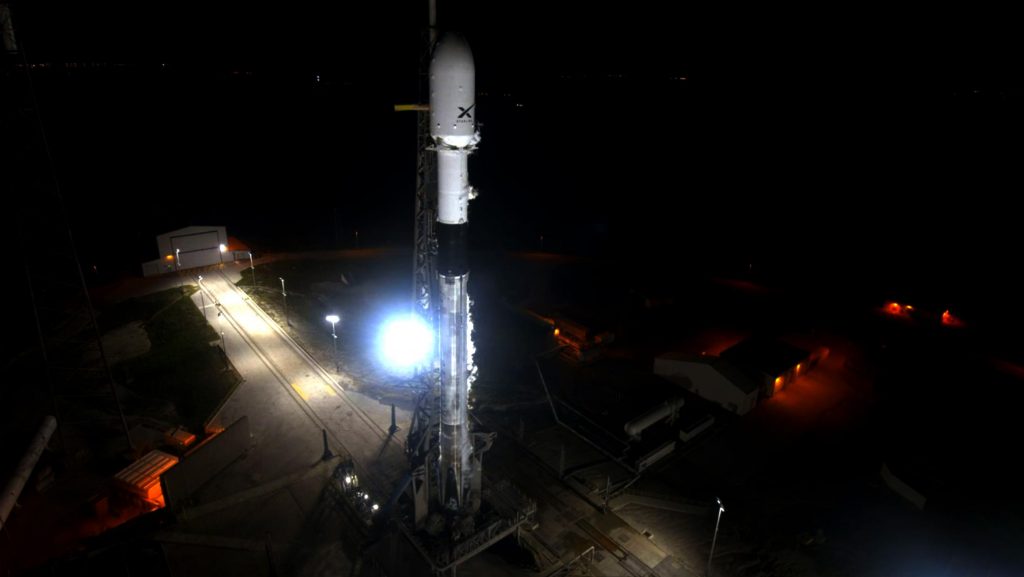
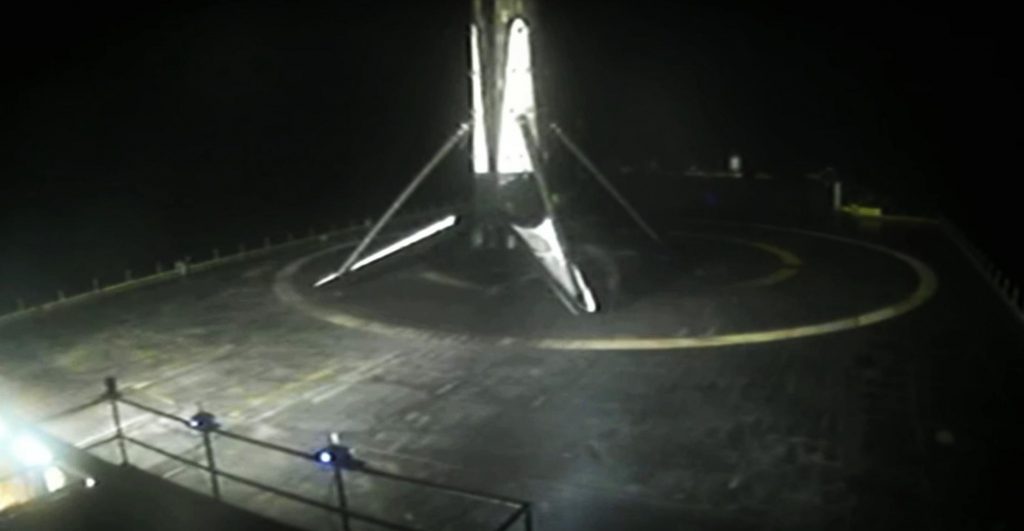

In fact, fairing recovery ship GO Ms. Tree is perhaps just a few minutes away from her third successful fairing half catch – set to occur roughly 45 minutes after Falcon 9’s 9:19 pm EST liftoff. At the same time, Falcon 9’s upper stage is coasting in low Earth orbit (LEO) and preparing to ignite one more time to circularize its orbit and send SpaceX’s third batch of 60 Starlink satellites on their way. Stay tuned for updates later tonight!
Check out Teslarati’s Marketplace! We offer Tesla accessories, including for the Tesla Cybertruck and Tesla Model 3.

News
Tesla starts showing how FSD will change lives in Europe
Local officials tested the system on narrow country roads and were impressed by FSD’s smooth, human-like driving, with some calling the service a game-changer for everyday life in areas that are far from urban centers.

Tesla has launched Europe’s first public shuttle service using Full Self-Driving (Supervised) in the rural Eifelkreis Bitburg-Prüm region of Germany, demonstrating how the technology can restore independence and mobility for people who struggle with limited transport options.
Local officials tested the system on narrow country roads and were impressed by FSD’s smooth, human-like driving, with some calling the service a game-changer for everyday life in areas that are far from urban centers.
Officials see real impact on rural residents
Arzfeld Mayor Johannes Kuhl and District Administrator Andreas Kruppert personally tested the Tesla shuttle service. This allowed them to see just how well FSD navigated winding lanes and rural roads confidently. Kruppert said, “Autonomous driving sounds like science fiction to many, but we simply see here that it works totally well in rural regions too.” Kuhl, for his part, also noted that FSD “feels like a very experienced driver.”
The pilot complements the area’s “Citizen Bus” program, which provides on-demand rides for elderly residents who can no longer drive themselves. Tesla Europe shared a video of a demonstration of the service, highlighting how FSD gives people their freedom back, even in places where public transport is not as prevalent.
What the Ministry for Economic Affairs and Transport says
Rhineland-Palatinate’s Minister Daniela Schmitt supported the project, praising the collaboration that made this “first of its kind in Europe” possible. As per the ministry, the rural rollout for the service shows FSD’s potential beyond major cities, and it delivers tangible benefits like grocery runs, doctor visits, and social connections for isolated residents.
“Reliable and flexible mobility is especially vital in rural areas. With the launch of a shuttle service using self-driving vehicles (FSD supervised) by Tesla in the Eifelkreis Bitburg-Prüm, an innovative pilot project is now getting underway that complements local community bus services. It is the first project of its kind in Europe.
“The result is a real gain for rural mobility: greater accessibility, more flexibility and tangible benefits for everyday life. A strong signal for innovation, cooperation and future-oriented mobility beyond urban centers,” the ministry wrote in a LinkedIn post.
News
Tesla China quietly posts Robotaxi-related job listing
Tesla China is currently seeking a Low Voltage Electrical Engineer to work on circuit board design for the company’s autonomous vehicles.

Tesla has posted a new job listing in Shanghai explicitly tied to its Robotaxi program, fueling speculation that the company is preparing to launch its dedicated autonomous ride-hailing service in China.
As noted in the listing, Tesla China is currently seeking a Low Voltage Electrical Engineer to work on circuit board design for the company’s autonomous vehicles.
Robotaxi-specific role
The listing, which was shared on social media platform X by industry watcher @tslaming, suggested that Tesla China is looking to fill the role urgently. The job listing itself specifically mentions that the person hired for the role will be working on the Low Voltage Hardware team, which would design the circuit boards that would serve as the nervous system of the Robotaxi.
Key tasks for the role, as indicated in the job listing, include collaboration with PCB layout, firmware, mechanical, program management, and validation teams, among other responsibilities. The role is based in Shanghai.
China Robotaxi launch
China represents a massive potential market for robotaxis, with its dense urban centers and supportive policies in select cities. Tesla has limited permission to roll out FSD in the country, though despite this, its vehicles have been hailed as among the best in the market when it comes to autonomous features. So far, at least, it appears that China supports Tesla’s FSD and Robotaxi rollout.
This was hinted at in November, when Tesla brought the Cybercab to the 8th China International Import Expo (CIIE) in Shanghai, marking the first time that the autonomous two-seater was brought to the Asia-Pacific region. The vehicle, despite not having a release date in China, received a significant amount of interest among the event’s attendees.
Elon Musk
Elon Musk and Tesla AI Director share insights after empty driver seat Robotaxi rides
The executives’ unoccupied tests hint at the rapid progress of Tesla’s unsupervised Robotaxi efforts.

Tesla CEO Elon Musk and AI Director Ashok Elluswamy celebrated Christmas Eve by sharing personal experiences with Robotaxi vehicles that had no safety monitor or occupant in the driver’s seat. Musk described the system’s “perfect driving” around Austin, while Elluswamy posted video from the back seat, calling it “an amazing experience.”
The executives’ unoccupied tests hint at the rapid progress of Tesla’s unsupervised Robotaxi efforts.
Elon and Ashok’s firsthand Robotaxi insights
Prior to Musk and the Tesla AI Director’s posts, sightings of unmanned Teslas navigating public roads were widely shared on social media. One such vehicle was spotted in Austin, Texas, which Elon Musk acknowleged by stating that “Testing is underway with no occupants in the car.”
Based on his Christmas Eve post, Musk seemed to have tested an unmanned Tesla himself. “A Tesla with no safety monitor in the car and me sitting in the passenger seat took me all around Austin on Sunday with perfect driving,” Musk wrote in his post.
Elluswamy responded with a 2-minute video showing himself in the rear of an unmanned Tesla. The video featured the vehicle’s empty front seats, as well as its smooth handling through real-world traffic. He captioned his video with the words, “It’s an amazing experience!”
Towards Unsupervised operations
During an xAI Hackathon earlier this month, Elon Musk mentioned that Tesla owed be removing Safety Monitors from its Robotaxis in Austin in just three weeks. “Unsupervised is pretty much solved at this point. So there will be Tesla Robotaxis operating in Austin with no one in them. Not even anyone in the passenger seat in about three weeks,” he said. Musk echoed similar estimates at the 2025 Annual Shareholder Meeting and the Q3 2025 earnings call.
Considering the insights that were posted Musk and Elluswamy, it does appear that Tesla is working hard towards operating its Robotaxis with no safety monitors. This is quite impressive considering that the service was launched just earlier this year.








